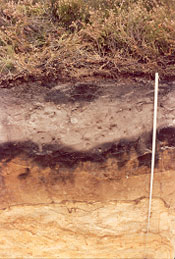|
|
|
 |
 |
 |
 |
 |
| Ron Allen's soil and water pages |
|
|
|
| |
|
| |
| English Nature Magazine: England's Glory |
|
|
| Ron Allen, Environmental Consultant, Euro-Biologist and a specialist in applying the earth sciences to wildlife conservation, is a partner in the Environmental Project Consulting Group where he combines expertise in both the soil and ecological sciences to advise English Nature and others on habitat management and wildlife conservation . Here he describes one of the strangest and least known parts of one our best known wildlife habitats. |
It was in the early 1970s, shortly after I started working in Essex, that I first came across ‘ancient’ soils, formed perhaps 250-400,000 years ago when England had a warm temperate if not almost sub-tropical climate. These soils, reddish at depth, enriched in clay and affected by later frozen conditions are complex enough, but it was only after moving to Hampshire that I came to realise the full glory of an even more complex soil, the ‘stagnogley podzol’. Not only are they ancient at depth, but they have been strongly affected by early agriculture in the Bronze Age and later, by the extreme acidity brought on by the spread of heathland. In short, dig a hole in a stagnogley podzol and you can see the history of perhaps the last half million years.
| 
|
So, just what is a Stagnogley Podzol? A Womble would know because these soils occur on Wimbledon Common. As a womble digs, he will pass through a sequence of brown, light grey, black, and orange and grey mottled layers. Each of these layers has a real story to tell that is more interesting than any fictional creature. Such soils also occur in parts of the New and Ashdown Forests, and the Surrey Heaths, but almost nowhere else in Britain. To be interested in Stagnogley Podzols you have to be interested in the humid and wetter heathlands. This is because these soils combine the extreme nutrient deficiency, acidity and seasonal wetness needed to support this ancient habitat.
To find out more about these soils I dug a series of holes in the New Forest (having first obtained permission from the Forestry Commission).
At about 1m down, I found gravels with reddish yellow clay between the flints indicating a long period of near subtropical soil formation. Examining thin sections under a microscope further revealed tiny fractured parcels of clay less than a millimetre across which indicated severe frost action. Larger blue-grey streaks criss-crossing the red colours indicated where the soil cracked as it froze during arctic conditions. These deep layers clearly demonstrate the effects of the alternating warm interglacial and cold glacial periods of the Ice Ages.
But it is the upper layers that have been affected by man. Very pale layers show how the soils have been leached following felling of the native woodlands for early agriculture. Very striking is a layer of pale fine sand completely devoid of nutrients and underlain by a compact black layer rich in organic matter and below that an orange layer rich in iron and aluminium oxides. Rain water easily passes down through the sandy layer but ponds up above the clayey substrate leading to seasonally waterlogging.
As early man cleared these relatively poor soils for cropping, they soon became exhausted of nutrients leading to invasion by heather. With trees gone, nutrient recycling from root uptake and leaf fall ended and the soils became acidified by organic acids leached from the invading heather. Continued removal of heather by commoners during the medieval period led to further nutrient depletion, acidification and soil degradation until today we have the stagnogley podzol.
The story these layers tell, is the history of our countryside, of the ice ages and of man’s fight (and failure) to tame the landscape and the development of our heathlands. The Stagnogley Podzol, one of the strangest of English soils, tells all to those that look and care to understand. Next time you take a walk in the New Forest, or in Ashdown Forest, or on Wimbledon Common, think also of the soils below your feet. Their story is stranger than fiction.
Copyright Ron Allen, January 1998 |
|
|
|
|
|
|
 |
 |
 |
 |
The Environmental Project Consulting Group
44A Winchester Road, Petersfield, Hampshire GU32 3PG
email: Ron Allen, tel: 01730 231019,
Copyright April 2005 Ron Allen
Geologist, Soil Scientist, Applied Ecologist, Hydro-ecologist, Chartered Environmentalist
|
|
|
|
|